Towards panchromatic Fe(ii) NHC sensitizers via HOMO inversion†
Abstract
A combined experimental and theoretical study of iron(II) complexes with pyridyl N-heterocyclic carbene ligands is presented, with a new focus on the effect of extending the ligands with thiophenes of variable number. In agreement with recent theoretical predictions by the Jakubikova group, these ligands induce a substantial mixture of the occupied t2g and π HOMO orbitals, as manifested by a near 80 nm red-shift of the 1MLCT transition and a 2–3 fold increase of the molar extinction coefficient. The thiophene moieties permit delocalisation of the MLCT state on the ligands, which results in excited state lifetimes in the 13–18 ps range, almost twice as much as for the reference compound lacking the thienyl substituents. Relaxation into 3MC states remains the main 3MLCT quenching mechanism, and the effect of the number of thiophenes in lengthening the 3MLCT lifetime is qualitatively consistent with a reduction in the 3MLCT–3MC energy gap.

- This article is part of the themed collection: Recent Open Access Articles in Frontiers Journals


 Please wait while we load your content...
Please wait while we load your content...